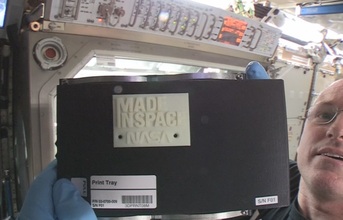
NASA's International Space Station's 3-D printer has manufactured the first 3-D printed object in space, paving the way to future long-term space expeditions.
"This first print is the initial step toward providing an on-demand machine shop capability away from Earth," said Niki Werkheiser, project manager for the International Space Station 3-D Printer at NASA's Marshall Space Flight Center in Huntsville, Alabama. "The space station is the only laboratory where we can fully test this technology in space."
NASA astronaut Barry ‘Butch' Wilmore, Expedition 42 commander aboard the International Space Station, installed the printer on Nov. 17 and conducted the first calibration test print. Based on the test print results, the ground control team sent commands to realign the printer and printed a second calibration test on Nov. 20.
These tests verified that the printer was ready for manufacturing operations. On Nov. 24, ground controllers sent the printer the command to make the first printed part: a faceplate of the extruder's casing. This demonstrated that the printer can make replacement parts for itself.
The 3-D printer uses a process formally known as additive manufacturing to heat a relatively low-temperature plastic filament and extrude it one layer at a time to build the part defined in the design file sent to the machine.
On the morning of Nov. 25, Wilmore removed the part from the printer and inspected it. Part adhesion on the tray was stronger than anticipated, which could mean layer bonding is different in microgravity, a question the team will investigate as future parts are printed.
Wilmore installed a new print tray, and the ground team sent a command to fine-tune the printer alignment and printed a third calibration coupon. When Wilmore removes the calibration coupon, the ground team will be able to command the printer to make a second object.
The ground team makes precise adjustments before every print, and the results from this first print are contributing to a better understanding about the parameters to use when 3-D printing on the space station.
"This is the first time we've ever used a 3-D printer in space, and we are learning, even from these initial operations," Werkheiser said. "As we print more parts we'll be able to learn whether some of the effects we are seeing are caused by microgravity or just part of the normal fine-tuning process for printing. When we get the parts back on Earth, we'll be able to do a more detailed analysis to find out how they compare to parts printed on Earth."
(Continued on the next page)
By Bill Hubscher
International Space Station Program Science Office
NASA's Marshall Space Flight Center
